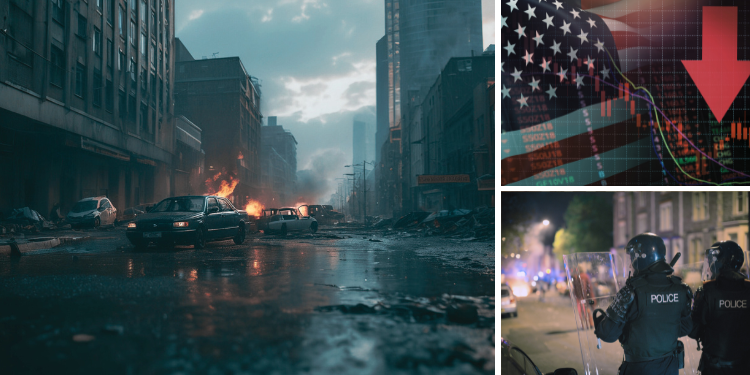It’s a question that many of us are afraid to ask but can’t ignore any longer. Is the United States on the verge of a massive collapse? Signs are all around us, whispering — or even shouting — that something is about to give. The nation that once prided itself on being a beacon of stability and prosperity is now teetering on the edge of an uncertain future. From economic instability and political turmoil to resource shortages, all signs point to a coming crisis. But are these just fleeting storms, or is this a signal of a larger, inevitable collapse?
Let’s take a look at the indicators that suggest America may be headed for a breakdown. Strap in, because this ride may get a little bumpy.
Economic Instability: The Ticking Time Bomb
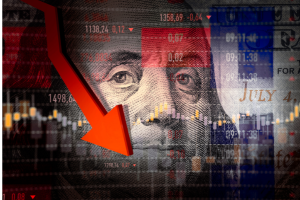 One of the clearest signs that the United States is on shaky ground is economic instability. The American economy has often been compared to a house of cards—each card being another fragile piece of a system that could collapse if just one card falls.
One of the clearest signs that the United States is on shaky ground is economic instability. The American economy has often been compared to a house of cards—each card being another fragile piece of a system that could collapse if just one card falls.
Massive national debt, rising inflation, a stagnant job market, and an over-reliance on printed money have all combined to create a perfect storm.
Consider the rising national debt, which currently stands at over $36 trillion. That’s $36,000,000,000,000 — a number so large that it’s almost meaningless to the average person. The problem? It’s not meaningless to the people and nations holding that debt. As interest rates rise, the cost of servicing this debt increases, leaving less money for essential services. Essentially, we’re paying off our credit cards with another credit card, and eventually, the lenders are going to want their money back.
Add to that the skyrocketing cost of living. Inflation has been chipping away at the average person’s buying power, and it’s no surprise that Americans are finding it harder and harder to afford basic necessities. Rent, food, gas—you name it—everything costs more, while wages aren’t keeping pace. The gap between the wealthy and the poor has grown so vast that it’s almost as if they’re living in two different countries. The best thing you can do right now is to be as self-sufficient as possible. You can start with this hidden food-growing fence you can add to your backyard, away from any prying eyes.
Political Turmoil: The Divide Widens
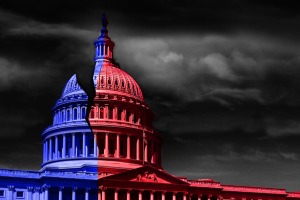 You don’t need to be a political analyst to see that the United States is deeply divided. Red versus blue, left versus right—it feels like we’re living in an era where people are less interested in finding common ground and more interested in proving that the “other side” is the enemy. This is more than just typical political banter; it’s reaching a boiling point.
You don’t need to be a political analyst to see that the United States is deeply divided. Red versus blue, left versus right—it feels like we’re living in an era where people are less interested in finding common ground and more interested in proving that the “other side” is the enemy. This is more than just typical political banter; it’s reaching a boiling point.
The recent re-election of Donald Trump in 2024 has only deepened these divisions. While some celebrate his return, others see it as a catalyst for further instability. Trump’s victory was not without drama—he survived two assassination attempts during the presidential campaign, which has only added fuel to the fire. The fact that these attempts occurred speaks to just how fragile the political climate is, and how far people are willing to go when they feel unheard or threatened.
The constant political gridlock in Washington D.C. means that important decisions are either delayed or never made at all. Congress seems unable to agree on anything, even when the stakes are at their highest. The two-party system—once a proud staple of American democracy—has become more about maintaining power than serving the people. Leaders are more focused on short-term wins for their party than the long-term health of the nation.
Resource Shortages: The Looming Scarcity

When we think of collapse, many of us picture empty grocery store shelves, long gas lines, or electricity blackouts.
The reality is, we’re already seeing signs of resource shortages that point toward a much larger crisis.
Water, for instance, is becoming a scarce resource in many parts of the country. States like California and Arizona have been battling droughts for years, and the overuse of the Colorado River has led to critical shortages. Many Americans still live under the illusion that clean water will always be available—but as shortages spread, it’s becoming increasingly clear that this is a dangerous assumption. This awesome DIY device that extracts water out of thin air could be a great addition to your property.
Food shortages are also becoming more frequent. Whether it’s supply chain disruptions, extreme weather, or poor agricultural yields, the reality is that our food system is vulnerable. Global instability only adds to the problem—if we’re reliant on imported goods, then any disruption outside the U.S. affects our supply here at home. The ‘just-in-time’ delivery model, where supplies arrive exactly when needed, leaves no room for errors or delays. The shelves may be stocked today, but one significant crisis could change that overnight.
The Real Estate Market: Another Domino?
 The housing market, which was a central player in the 2008 financial crisis, looks unstable again. While some areas have seen home values soar, others are seeing stagnant or dropping prices—a sign that demand is inconsistent and the market is losing its balance.
The housing market, which was a central player in the 2008 financial crisis, looks unstable again. While some areas have seen home values soar, others are seeing stagnant or dropping prices—a sign that demand is inconsistent and the market is losing its balance.
Mortgage rates are rising, making homes unaffordable for many first-time buyers. We could be on the brink of another housing bubble burst, which would have disastrous consequences for the entire economy.
Homelessness is also becoming an increasingly visible issue. Cities like Los Angeles, San Francisco, and Seattle have seen tent encampments become a permanent part of the landscape. When more and more people are unable to afford a roof over their head, you can be sure that societal collapse is inching closer.
The Ever-Present Threat of Civil Unrest
 We’ve already seen glimpses of what civil unrest in America looks like, and it’s not pretty. Whether it’s protests over police violence, government mandates, or election results, tensions are simmering.
We’ve already seen glimpses of what civil unrest in America looks like, and it’s not pretty. Whether it’s protests over police violence, government mandates, or election results, tensions are simmering.
With each new event, it feels like we’re one spark away from all-out chaos.
The average person—caught between the political wrangling, economic uncertainty, and resource scarcity—is angry. And angry people eventually take to the streets. Here is how you can avoid being targeted during civil unrest.
The proliferation of weapons in the U.S. adds another layer of danger to the situation. With millions of firearms in civilian hands and groups on both ends of the political spectrum willing to take drastic actions, the potential for widespread violence is real. One significant event—a contested election, a financial collapse, or another high-profile act of violence—could easily push us over the edge.
Global Challenges Add Fuel to the Fire
While we focus on domestic issues, it’s important not to ignore the international factors that could impact America’s future. The rise of China as a global superpower has shifted the balance of power, and tensions between the U.S. and China are heating up—whether it’s trade, military presence in the South China Sea, or technology. It’s no secret that China wants to dethrone the U.S. as the world’s leading power, and the competition is growing fiercer by the day.
Related: 6 Warning Signs Before An Economic Collapse That Most People Miss
Meanwhile, our relationships with traditional allies are also under strain. Trust in America as a stable partner is declining, and geopolitical shifts are causing global uncertainty. A nation that once led the world is now struggling to keep up, and that kind of instability at the top often leads to ripple effects that reach every level of society.
What Could Trigger the Collapse?
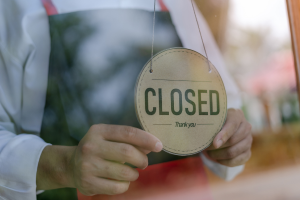 It’s not just one thing that’s going to bring the United States to its knees; it’s the combination of all these issues—economic fragility, political unrest, resource scarcity, civil discord, and international tensions. But the scariest part is that any one of these issues could be the domino that sets off the rest.
It’s not just one thing that’s going to bring the United States to its knees; it’s the combination of all these issues—economic fragility, political unrest, resource scarcity, civil discord, and international tensions. But the scariest part is that any one of these issues could be the domino that sets off the rest.
Imagine a scenario where inflation continues to rise unchecked, and people’s savings are wiped out. This financial distress could lead to increased crime, protests, and general disorder. The government, already struggling to control the chaos, could impose draconian measures that further erode public trust. This could be followed by resource shortages that make daily living a challenge—when people can’t feed their families or get access to clean water, things tend to get ugly fast.
And it’s not hard to imagine a foreign actor seizing this opportunity to push their agenda, further destabilizing the country. A cyberattack on critical infrastructure—like the power grid—could bring life as we know it to a grinding halt. A sudden, drastic event like this could be the final nail in the coffin.
Is There Hope?
So, is the United States really on the brink of collapse? The truth is, no one can predict the future with certainty. The signs are troubling, and if we continue on our current trajectory, the outlook is bleak. However, it’s also important to remember that America has faced major challenges before and emerged stronger. It’s in the DNA of the nation to persevere.
But this time feels different. The divisions are deeper, the stakes are higher, and the willingness to compromise is nearly non-existent. The future is not written in stone, but it’s up to the people—that’s us—to steer the ship away from the storm.
In these uncertain times, being prepared for whatever comes next isn’t just a good idea; it’s essential. Whether it’s stocking up on essential supplies, building community resilience, or simply staying informed, the best thing you can do is be ready. Because if the United States is indeed on the brink of collapse, it won’t be pretty—but those who are prepared stand the best chance of weathering the storm.
You may also like:
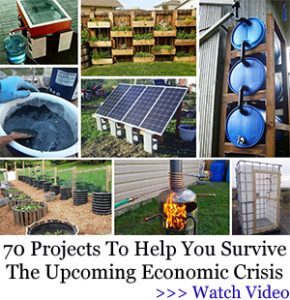 These Common Items Will Become a Luxury When SHTF
These Common Items Will Become a Luxury When SHTF
3 Things to Get Done Before the Economic Collapse (Video)
Awesome Places to Hide Your Guns
10 Nuclear War Movies You Should Watch Before It’s Too Late
Painkiller in a Jar
Read the full article here
